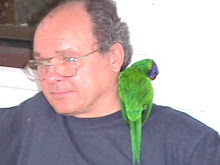 Grey Butcherbird
Grey Butcherbird
Awake and armed with trusty notebook and pen by 0400 hours. No need to panic, we’re not insomniacs. We’re putting together a paper on the “Early Risers” of a Queensland semi-rural environment. For those interested, while that infamous companion to all good Tarzan films, the Laughing Kookaburra, is often the first, this morning the humbler Willie Wagtail [who is actually a fantail, but then this is Australia] pipped Dacelo leachi to the post.
Up and out by 0530 hours – this is subtropical Queensland, in the summer, and it gets HOT, early.
Admittedly the past three days have seen outstanding downpours with temperatures as low as the mid-20s but on the other hand the weather has been a little unpredictable and we decided to err on the side of caution.
The drive into Nanango produced the usual motley mob, including what has become the traditional first tick on our Year List- the humble House Sparrow, Passer domesticus. Some may well refer to this plain, unassuming bird as a “thrash tick” but it reminds us of younger days gadding around Staffordshire – and whatever else you think of this little fellow, you can’t help but admire the creature’s tenacity. Mankind has cast the species to all the far fetched corners of the globe and the little bugger continues to defy the odds and survive. [Aside: is this what he meant by “inane ravings”?]
First port of call was the Grey Street Sewage Treatment Plant.
And for those who have not experienced birding beyond the flush toilet, many remoter parts of Australia [and no doubt other parts of the world] use settling ponds to process their sewage. While smelly –and you really should treat your olfactory organs to the aromatic delights of the settling ponds outside Darwin, Northern territory- these area do attract birds. We saw our first Pink-eared Duck revelling in the assorted curds and wheys.
Oddly enough, on this occasion, there were conspicuously fewer species, 22. It’s all that rain we’ve been having over the past three days. Dams and myriad minor waterholes have filled; consequently the average bird has a far greater range to roam over in search of water.
The Cattle Egrets were there in force. 200+. In breeding plumage and nesting.
Taxonomically the bird seems to have been around the Wrekin: Bubulcus, Ardeola and Ardea. Down Under it’s Ardea ibis. The rest of the birding world appears to be more content with Bubulcus ibis. To all intents and purposes we share the same bird, albeit slightly different taxa.
Thankfully there were other birds around but again not , a couple of Purple Swamphens, half a dozen Dusky Moorhens, a similar number of Little Black Cormorant [arguing the toss with the Egrets as to arboreal living space rights], two Little Pied Cormorants, a Straw-necked Ibis [flying by overhead] and two Grey Teal.
As is our wont, from the sewage plant we headed back home via the Pioneer Park, a small urban park abutting the main street and the local school football oval. As usual, a great place for the Australian Reed-Warbler but for the second time we also had magic views of a trio of Restless Flycatchers.
 Pied Butcher
Pied Butcher
THE TALLY {YEAR LIST 2010}
Using Christidis & Boles taxonomy.
1. our own “backyard” [7½ acres]
2. en route to and/or returning from Nanango
3. Sewage Treatment Plant
4. Pioneer Park
Australian Wood Duck 1]
Grey Teal 3]
Pacific Black Duck [4]
Australasian Grebe [3]
Crested Pigeon [1,2,3,4]
Spotted Dove [2]
Peaceful Dove [1]
Bar-shouldered Dove [1]





